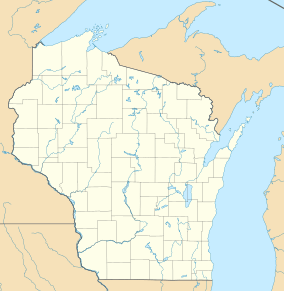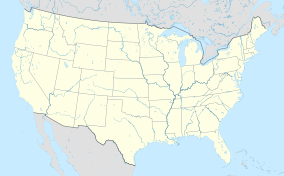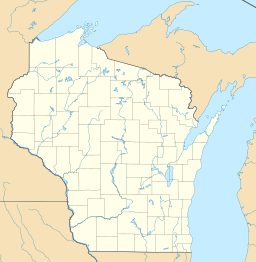Mirror Lake State Park facts for kids
Quick facts for kids Mirror Lake State Park |
|
|---|---|
|
IUCN Category V (Protected Landscape/Seascape)
|
|
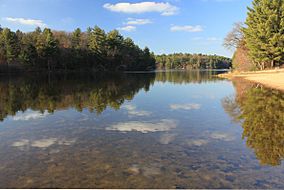
Clear waters of Mirror Lake
|
|
| Location | Sauk, Wisconsin, United States |
| Area | 2,179 acres (8.82 km2) |
| Established | 1962 |
| Governing body | Wisconsin Department of Natural Resources |
| Mirror Lake | |
|---|---|
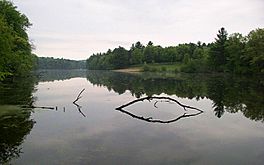
The lake gets its name from its often-still surface
|
|
| Location | Wisconsin Dells region |
| Coordinates | 43°33′54″N 89°49′12″W / 43.565°N 89.820°W |
| Type | Reservoir |
| Primary inflows | Dell Creek |
| Primary outflows | Dell Creek |
| Basin countries | United States |
| Surface area | 137 acres (55 ha) |
| Average depth | 14 ft (4.3 m) |
| Max. depth | 19 ft (5.8 m) |
Mirror Lake State Park is a beautiful Wisconsin state park covering 2,179-acre (882 ha) in the Wisconsin Dells area. It officially opened on August 19, 1966. The park is home to Mirror Lake, a narrow lake with tall sandstone cliffs up to 50 feet (15 m) high.
The lake itself is 137 acres (55 ha) big and usually 10 to 14 feet (3.0 to 4.3 m) deep. Because it's protected from the wind, the water on Mirror Lake is often very calm. It can be so smooth that it looks just like a mirror, which is how it got its name! This park is a popular spot for tourists. It has a large campground and many other things for visitors to enjoy. You can also find the Seth Peterson Cottage here, a special building designed by famous architect Frank Lloyd Wright that people can rent.
Contents
Nature and Landscape
How the Land Was Formed
The rocks you see in the park are made of sandstone. This sandstone formed about 500 million years ago. Back then, this area was covered by shallow inland seas. Much later, about 20,000 to 10,000 years ago, a huge sheet of ice called a glacier moved through Wisconsin. This glacier passed just east of the park.
Scientists believe that Dell Creek, a stream that flows into the Wisconsin River, was blocked by dirt and rocks left by the glacier. This forced the creek to change direction. Over a long time, Dell Creek carved a deep, narrow valley into the soft sandstone. The steep cliffs show that this part of the creek is much newer than other parts upstream.
Trees and Plants
The area around Mirror Lake is covered by a forest of pine and oak trees. You'll see many eastern white pines. Red pines grow especially well on top of the sandstone cliffs near the water. The park also has different kinds of oak trees, like white, red, and black oaks.
Park History
The Old Mill and Dam
The stream called Dell Creek was first blocked by a dam in 1860. This dam was built to power a watermill owned by Horace LaBar. Early maps of the area called the lake "LaBar's Pond." The mill mainly made flour.
Over the years, the mill had different owners. In 1893, the Timme family bought it. The original wooden dam was getting old, so it was fixed and then replaced with a concrete one in 1925. The Timme Mill became famous for its special self-rising pancake flour. The Timmes sold the mill in 1947. The new owners kept making pancake flour for about ten more years. But in 1957, the mill burned down, and the owners went out of business.
Special Natural Areas
In 2003, the northwest part of the park became part of the Wisconsin State Natural Areas Program. This was because of its amazing plant life. It's now known as the Mirror Lake Pine Oak Forest State Natural Area. Another special area within the park is called Fern Dell Gorge. These areas help protect important natural habitats.
Fun Things to Do
Mirror Lake State Park offers many ways to have fun outdoors.
Camping and Lodging
The park has 151 campsites. Forty-seven of these sites have electricity. There are also seven group campsites. Each group site can hold up to 20 people in tents. For a unique stay, you can even rent the Seth Peterson Cottage. This special cabin was designed by the famous architect Frank Lloyd Wright.
Boating and Swimming
Mirror Lake is a special no-wake zone. This means boats cannot go fast enough to create big waves. The lake is too small and narrow for speedboats. Also, big waves would damage the soft sandstone cliffs along the shore.
You can rent different types of boats near the boat ramp. The park is a very popular place for kayaking and canoeing. The lake has three "fingers" that are easy to paddle. The beautiful cliffs make it a great place to explore by water. There's also a 200-foot (60 m) swimming beach. Next to the beach, you'll find a nice picnic area.
Trails for Everyone
The park has many miles of trails for different activities:
- 28.4 miles (45.7 km) of hiking trails
- 17.4 miles (28.0 km) of cross-country skiing trails
- 9.2 miles (14.8 km) of mountain biking trails
- 1.2 miles (1.9 km) of snowshoeing trails
Accessibility for All
Mirror Lake State Park has features designed for visitors who use wheelchairs. It was the first Wisconsin state park to have an accessible camper cabin, built in 1991. There is also a half-mile trail, a fishing pier, and a picnic shelter that are all wheelchair-friendly.
Fishing in Mirror Lake
If you enjoy fishing, Mirror Lake is a great spot. The most common fish you can catch here include panfish, bass, walleye, and northern pike.
Images for kids
- Wisconsin Department of Natural Resources. Mirror Lake State Park signage, brochures, and website.


